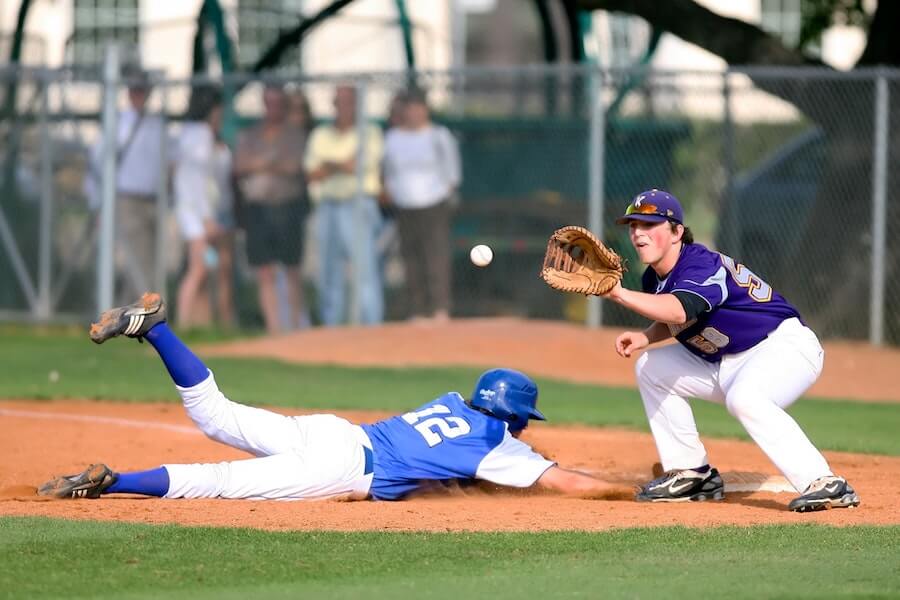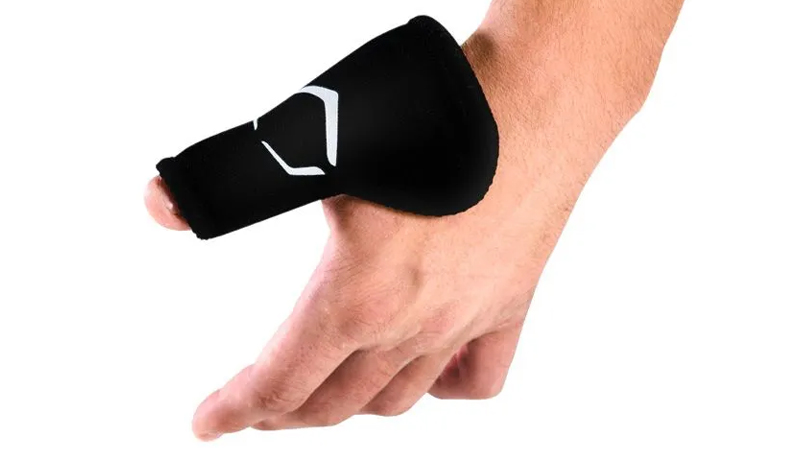Almost every baseball catcher has experienced a common sports injury known as a “catcher’s thumb” injury.

This injury primarily impacts the thumb’s ulnar collateral ligament (UCL), resulting in discomfort, instability, and diminished hand function.
This article attempts to provide a quick yet thorough explanation of the catcher’s thumb, its causes, symptoms, diagnosis, treatment choices, and prevention measures, whether you’re an athlete, a worried parent, or someone looking for information on this ailment.
Symptoms of Catcher’s Thumb Injury
Recognizing the symptoms catcher’s injury is essential for an early diagnosis and the proper medical care. If you’re wondering what the symptoms of this injury are, here are the common ones.
Pain and tenderness
Concentrated pain and soreness in the thumb are two main signs of a catcher’s thumb injury. Usually, this discomfort is felt in the joint where the thumb attaches to the hand or at the base of the thumb.
This pain can range in intensity from discomfort to acute, searing pain. Activities like pinching, grasping, or light touching may trigger sharp pain or discomfort.
The pain may worsen during activities that strain the thumb, such as catching a fast-moving ball or throwing.
Swelling and Inflammation
Catcher’s Thumb injury often leads to swelling and inflammation around the thumb area. The affected region may appear visibly swollen and feel warm to the touch. Swelling can impede normal movement and cause discomfort.
Weakness and Instability
This injury can weaken the grip strength of the affected hand. You may notice a decreased ability to hold onto objects firmly or experience a sense of instability in the thumb joint.
This weakness can impact your performance in activities that rely on a strong and stable grip, such as catching a baseball. You may even find playing your favorite game, baseball, very difficult.
This instability can impact your ability to accurately position or control the thumb during catching or throwing motions.
Bruising or Discoloration
In some cases, symptoms that you notice first are bruising or discoloration around the thumb area. The bruising may result from direct trauma or excessive strain on the thumb ligaments.
The coloration can range from mild discoloration to dark bruising, indicating tissue damage.
Stiffness and Reduced Flexibility
Catcher’s thumb injury can lead to stiffness and reduced flexibility in the thumb joint. You may notice difficulty in bending or straightening the thumb smoothly.
This stiffness can make simple tasks, such as discomfort while gripping a baseball or holding a bat.
Numbness
Sometimes, you may notice numbness or tingling in the thumb or surrounding areas. This sensation, known as paresthesia, can occur due to nerve compression or irritation from the injury.
It may be intermittent or persistent, depending on the severity of the condition.
Treatment Options for Catcher’s Thumb Injury
If you’re currently experiencing any of the signs above, then these are the things you should do:
Rest
One of the initial steps in treating a catcher’s thumb injury is to provide adequate rest to the affected thumb.
This involves avoiding activities that exacerbate the symptoms and may require modifying or temporarily discontinuing participation in baseball or other activities that strain the thumb.
Immobilization techniques, such as a thumb splint or brace, can help stabilize the thumb, promote healing, and prevent further injury.

Cold Therapy
Ice packs or cold compresses can apply cold therapy to an injured thumb to relieve pain, inflammation, and edema. Several times a day, 15-20 minutes should be dedicated to cold treatment.
Compression can also help lessen swelling and support a wounded thumb through an elastic bandage or compression sleeve.
Painkillers and Anti-inflammatory Drugs
NSAIDs, including ibuprofen or naproxen, are available over the counter and may be prescribed to treat pain and inflammation brought to the thumb during the game.
These drugs must be taken as prescribed and under the supervision of a medical expert.
Physical Therapy and Exercises
Once the acute symptoms have subsided, a healthcare professional may recommend a customized physical therapy program.
Through targeted exercises and therapeutic techniques, physical therapy can help restore thumb strength, flexibility, and range of motion.
These exercises may include thumb stretches, grip-strengthening exercises, and dexterity drills tailored to the specific needs of the individual.
Thumb Splints or Braces
Thumb splints or braces are commonly used to treat catcher’s thumb injury to provide stability, support, and protection to the injured thumb.
These devices help immobilize the thumb joint, allowing proper healing while limiting excessive movement or stress.
Thumb splints or braces are typically worn during activities that could strain the thumb, such as sports or repetitive tasks.
Surgical Interventions (if necessary)
Surgical intervention may be considered in severe cases of catcher’s thumb injury that does not respond to conservative treatments.
The thumb joint may need to be fixed, injured ligaments may need to be repaired, and any related problems may require surgery.
Depending on the precise type and severity of the damage, several surgical treatments and approaches usually are decided on a case-by-case basis in collaboration with a hand surgeon.
Game Modification and Gradual Return to Play
As part of the treatment plan for a catcher’s thumb injury, game modification is crucial to prevent re-injury and promote healing.
This may involve temporarily avoiding activities that strain the thumb excessively, such as catching or throwing.
Once the thumb has sufficiently healed, a gradual return-to-play protocol can be implemented under the guidance of a healthcare professional or physical therapist.
This enables the gradual reintroduce of baseball-related activities, ensuring proper healing and minimizing the risk of re-injury.
Hand Therapy and Manual Techniques
Hand therapy, performed by a certified hand therapist, can significantly rehabilitate a catcher’s thumb injury.
Hand therapists employ manual techniques, such as massage, joint, and soft tissue mobilization, to improve blood circulation, reduce scar tissue formation, and enhance overall thumb function.
These specialized techniques can expedite the healing process and optimize recovery outcomes.
Prevention Strategies for Catcher’s Thumb Injury
As part of the comprehensive treatment approach, education about preventive measures is essential in minimizing the risk of future thumb injuries. This includes:
Proper Catching Techniques and Training
Learning and practicing proper catching techniques can significantly reduce the catcher’s thumb injury risk during games.
This includes using correct hand positioning and grip techniques when catching a ball, avoiding excessive force or strain on the thumb, and maintaining proper body mechanics during catching movements.
Coaches, trainers, and experienced players can provide guidance and training to ensure appropriate technique execution.
Using Appropriate Protective Gear
Wearing appropriate protective gear, such as a well-fitted catcher’s mitt or glove, can help minimize the risk of thumb injuries while catching.
Choose equipment that provides adequate padding, support, and thumb protection. Regularly inspect gear for any signs of wear and tear and replace it as needed to maintain its effectiveness.

Maintaining Thumb Strength and Flexibility Through Exercises
Specific thumb exercises can help strengthen the thumb muscles and improve flexibility, reducing the likelihood of injury.
These exercises may include thumb opposition, resistance training with hand grips or therapy putty, and thumb stretches.
Incorporating these exercises into regular conditioning routines can enhance thumb stability and resilience.
Takeaway
While a catcher’s thumb injury can be a setback for catchers, with timely intervention and adherence to rehabilitation protocols, most players can return to their sport with minimal complications.
By implementing these prevention strategies, baseball catchers can significantly reduce the risk of a catcher thumb injury and maintain optimal thumb health.
Remember, prevention is key, and seeking timely medical attention can help protect the thumb and minimize the likelihood of injury.
Seeking medical attention at the earliest signs of thumb pain or instability is crucial to ensure a prompt diagnosis and appropriate treatment plan.

I was working as a mountain guide, probably all around the planet. One day, I met my wife in the mountains, literally on top of the world. Now, I have a beautiful family and three kids, so I don’t have much time for climbing, but sometimes I go camping with my friends. I am also into gym workouts, and I can’t imagine my life without sports.
Since I ended my professional career as a climbing guide, I’ve been giving personal classes and helping amateurs to get ready for conquering their first peaks. Also, that’s how the whole blog idea appeared.





